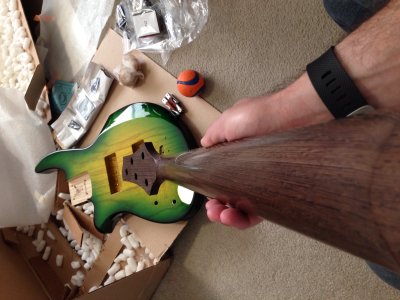Yep, that's the result. Your mileage may vary, especially according to the wood you're using. The burnishing part is easy and actually I find it quite relaxing. The headstock is another issue. You'll read a lot of different methods here and various other places.
The shellac is a good sealer/filler but with woods like Canary you have to let it dry good and sand it down smooth (I think I actually did two initial thick layers of zinsser spray on shellac on that first Canary headstock you posted, sanding with 600 grit in between. You've got to make it nice and flat. Sometimes shellac can be a nasty mess, or at least it is for me. The whole point of the shellac is to seal and "isolate" the wood, and to protect the decal from the acetone in the lacquer. Supposedly it can melt the letters, etc. On the current Canary neck I'm working with (not the picture above), I got pissed off at the shellac because it was bubbling, acting up, looking like shite, so I sanded it all the way bare flat and just went with
Mohawk Pre-Catalyzed Clear Satin Lacquer and first shot a few light coats on the wood, let dry 10 min apart (prolly 5 light misty coats). Then, sanded super light with
Zona 3M Wet/Dry Polishing Paper, applied the waterslide decal, let it dry overnight. Then started shooting nice medium coats of lacquer about 30 min apart, prolly 8 - 10 coats over a few days. Let sit for a day or two. Then took some 1500 grit and a sanding block to wet-sanded the initial hump from the decal flat, and then took back over with the green cloth polishing paper by hand while holding up to the light, and got it damn near perfect. I rubbed a little too hard on the tiny patent numbers at the bottom, so there is a slight melt through (have to look real close to see), but it looks awesome and it blends really well with the burnishing. So for me, I'm not going through all that shoot-sand-shoot-sand-shoot-sand crap. It's not necessary. Just build up a nice thing layer of lacquer on top of the decal and then go easy and sand it all down in one shot. I had tried BLO/thinner method (exactly as described by Tonar) over my burnishing on the back of the neck but it just made it sticky, even after buffing the shite out of it, so I used mineral spirits and just brought it back to the burnished finish.
So my latest experiment shows that the shellac is not necessary. It's a beast to sand off, too. The lacquer never messed up or distorted the decal lettering at all, not in the least. And, this Mohawk pre-catalyzed satin lacquer is a better product that Deft, I believe, and dries quicker and harder than Deft. Deft was soft and prone to checks and imprints. Mohawk is hard. Anyway, it's a learning process. I tend to do my own thing and not follow rules or what other people say. I'm sure you'll get those that'll say my way is wrong, etc. I don't give a f***. Wait till ya'll see the final product. It's bad as hell. Pics later.
 :help:
:help:



